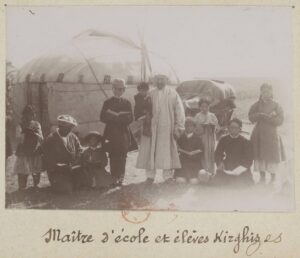The author would like to thank the Kunstkamera Museum for permission to use the photos of Samuil Dudin in this article. All images are reproduced here with the written permission of the Peter the Great Museum of Anthropology and Ethnography (the Kunstkamera). No further reproduction by third parties is possible without proper authorization from the museum.
A talented ethnographer, photographer, traveler, collector, artist, and researcher of the history and culture of Central Asia, Samuil Dudin (1863-1929) made his first expedition in 1891. Dudin was a participant in the Orkhon expedition and was involved in a study of Mongolian antiquities led by the scholar Vasily Radlov, who played a huge role in the young ethnographer’s fate. Radlov contributed not only to Dudin’s expeditionary work, but also to his studies in Ilya Repin’s class at the Academy of Arts in 1892-1898. The first expedition was followed by a second: in 1893-1894 Dudin, together with Vasily Barthold, visited the Semirechenskaya region, Tarbagatai, and Eastern Turkestan. On this expedition, Dudin was entrusted with pictorial and photographic representation.1 A few years later, Dudin, together with Sergei Oldenburg, went on two consecutive expeditions to Chinese Turkestan (1909-1910 and 1914-1915).2
In 1899, Dudin visited the Kazakhs of the Akmola, Semipalatinsk, and Semirechye regions.3 Kunstkamera researchers Valeriia Prishchepova and Inga Stasevich have reconstructed the route he took: from Jamantuz (40 3⁄4 versts) to the picket Kaidaul (30 1⁄4 versts) to the picket Chakchansky (Shakshak, 33 1⁄4 versts) to the Cossack village of Bayanaul (24 versts).4
The researcher captured his trip to the Kazakh steppes in immortal photos. Moreover, based on photographs, as well as on his drawings, drawings on paper, and “information from the Kazakhs,”5 Dudin prepared several publications devoted to the decorative and applied arts of Central Asia: “Kyrgyz ornament” (Kirgizskiī ornament), “Carpets of Central Asia” (Kovrovye izdeliia Sredneī Azii), “Woodcarving by Kyrgyz” (Rez’ba po derevu u Kirgiz), and “Central Asian Carpets” (Sredneaziatskie kovry).6
There are numerous parallels between Dudin’s photographs and the photographic collection of the earlier and very famous “Turkestan Album,” created on the order of the Governor-General of Turkestan, Peter Mikhailovich von Kaufman, but there are also differences between the two. The expedition to the Kazakh steppes was organized by the Peter the Great Museum of Anthropology and Ethnography, giving Dudin’s photos—unlike the politicized ones in the “Turkestan Album”7—genuine ethnographic value. Indeed, this photo collection should be designated as an ethnographic companion to the life of Kazakhs, primarily those who lived in the Semipalatinsk region. This photographic companion depicts the clothing, daily occupations, and decorative-applied arts of the Kazakhs of the late 19th century.
Traditional Clothing
In the photographs of Samuil Dudin, we see a lot of everyday clothes for men, women, and children. Men’s attire included unique elements: a winter hat known as tymak (Russian: malakhai)8 and a leather belt called kise (see Photo 1). The tymak was made from felt, fox fur, or astrakhan. This headdress was worn in the 20th century, especially by shepherds in winter pastures. Other necessary items of clothing for winter are a covered coat (ishik) and a sheepskin coat (ton); the latter was worn over a coat (shekpen) made of homespun cloth (see Photo 2).


Traditional Clothing
The leather kise with which the upper gown (shapan) was belted (see Photo 1) acquired an exclusively decorative character by the end of the 19th century, as Chokan Valikhanov has noted.9 Kise was replaced by the cotton belt belbeu10 (see Photo 1). The leather kise, a distinctive element of Kazakh dress, was decorated with embossing and figured overlays encrusted with silver and semi-precious stones. The kise was not merely decorative; a semi-circular bag with a flap (kalta or kise) was attached to the belt using special pendants and housed a fire-starter, flint, and other tools needed by a nomad (see Photo 3). On the other side of the belt hung a pouch with a knife and a pouch with bullets and gunpowder.

Dudin also depicted the kalpak, a man’s headdress popular among the Kazakhs and the Kyrgyz11. The kalpak was made of thin felt and its color helped to identify its owner: the rich chose snow-white kalpaks, while the poor wore black, gray, and brown ones. The kalpak was decorated with embroidery and patches of colored cloth. The Kazakh nobility wore kalpaks of velvet richly decorated with silk and gold thread embroidery.
The upper coat (shapan) was also worn by women, together with a long dress (koilek). Ruffles, which were very fashionable in the 19^th^ century, were used to decorate the dresses of girls and young women. Girls’ headwear (borik) was trimmed with fur (see Photo 4). Unlike similar men’s headdresses, fur was sewn to young women’s borik only on the outside.
The following photograph Photo 5 shows the girls in tunic-like koilek dresses made of printed chintz of Russian manufacture. The oldest woman wears a camisole and a headdress kimeshek of white calico. Similar kimeshek with modest embroidery were worn by women over the age of 40. One of the girls put on her head a shapan trimmed with colorful adras fabric (see Photo 5).
During this period, Russian cotton fabrics, which at first were more expensive than local ones, began to penetrate the region. As a result, clothing from that era was made from a wide variety of local Central Asian and Russian fabrics, as well as British, Indian, and Iranian textiles that were imported into the region. Photo 6 shows a Kazakh family in their yurt. Numerous felt trunk covers (karshyn) serve as a picturesque background.
 Photo 4. Kazakh girl costume. S.M. Dudin. 1899. Kazakhstan, Semipalatinsk Oblast. ©МАЭ РАН 2021
Photo 4. Kazakh girl costume. S.M. Dudin. 1899. Kazakhstan, Semipalatinsk Oblast. ©МАЭ РАН 2021
 Photo 5. Kazakh women. S.M. Dudin. 1899. Kazakhstan, Semipalatinsk Oblast (Saumal-Kul). ©МАЭ РАН 2021
Photo 5. Kazakh women. S.M. Dudin. 1899. Kazakhstan, Semipalatinsk Oblast (Saumal-Kul). ©МАЭ РАН 2021

In and Beyond the Yurt
The mobility of the Kazakhs influenced their culture and crafts. A whole series of photographs by Dudin, including “A group of girls during the aul movement” (Photo 7), clearly demonstrate the mobility of 19th-century Kazakh nomads, offering us insight not only into their daily lives, but also into the surrounding landscape.
Moving freely across the steppe, the nomads carried with them their mobile houses—yurts.
The preferred house of a nomad, the yurt is a tent 4 meters in diameter and 3-4 meters high with a conical roof. The yurt is covered with white felt that is 2 cm thick; a piece of felt is attached at the entrance and serves as a door.12
Dudin paid much attention to the yurts: their “movable architecture,”13 assembly, felt coverings, and interior decorations. He also photographed certain elements of the mobile dwelling—namely changarak, kerege, and tunduk14—and explored how these yurt parts were purchased. Photo 8 shows the purchase of a tunduk at the famous Kuyanda-Botov Fair. The fair took place for a month each year, from May 25 to June 25, between 1848 and 1930 in the valley of the river Taldy. The annual fair can be described as international: many traders and buyers from Kazakhstan, Siberia, the Urals, Central Asia, and China came to participate.15
Photo 9 shows how the women assembled the yurt and covered the wooden frame with felt. In winter, the yurt was wrapped with double felt, earth or snow was put on the bottom, and kerege (lattice walls) were put on the outside. Felt also reigned supreme in the interior decoration of the yurt, serving as the base for numerous carpets, storage bags, and chest covers (see Photo 10).




Felt Art and Embroidery
Dudin was not only a photographer; he also collected and studied objects featuring the decorative and applied arts of the Kazakhs. He was one of the first to talk about the need to preserve the decorative art of the steppe nomads, which had been gradually declining under the influence of “common European culture.”16 He described the craftsmanship of the peoples of Central Asia in vivid detail:
The love for colors and flair for them, the love for ornamental decoration of household items and the richness of this decoration are peculiar to the peoples of Central Asia. In the past, this tendency was undoubtedly revealed with greater force and on a larger scale than now […] It is extremely important to collect samples of everything that has been and is still being done in the region in terms of this art, as the materials collected so far are still insufficiently complete and systematic. Especially important in this sense are objects of those ethnic groups that have so far retained the urge to decorate domestic objects and do it on their own, without resorting to the help of artisans from other ethnic groups. If I am not deceived by my observations, I had the opportunity to meet such people during my travels in Central Asia in the time period from 1893 to 1914. They were Kyrgyz-Cossacks and Kara-Kyrgyz who lived in the Kyrgyz Republic (formerly the Governorate-General of the Steppe) and in the regions of Jetysu (Semirechenskaya), Syrdarya, Samarkand, and Fergana. What the reasons were that created this phenomenon, I am not certain, but one of them is clear to me: it is the fact that the Kyrgyz more fully preserved the nomadic way of life; almost nothing has changed in their way of life, despite all the impacts of cultures of neighboring nationalities.17
To support his conclusions, Dudin referred to photographs of the felt carpets syrmak (see Photo 11) and tekemet, the storage bags ayak kap, and other felt and leather items. These artisanal pieces served as the interior and exterior decoration for a yurt, like a felt door curtain (Photo 12).
It is interesting to note the similarity of the ornament on the different felt works, which is reminiscent of the tree of life. This highly stylized tree made of animal horns, where the lower part is like the roots of ancestors and the upper part the future generations of a large Kazakh family. The ornament on the felt rug syrmak and felt door (see Photos 11 and 12) is inlaid; the pattern was superimposed on the main background and then quilted and stitched along the contour of the pattern. Photo 13 depicts a felt storage bag ayak kap that is decorated with embroidery and felt appliqué.



In the paper on Kazakh ornamentation,18 Dudin shared his thoughts about embroidery, which, in his opinion, appeared later than the art of felting. However, this does not detract from its originality. He singled out three main embroidery stitches that are central to Kazakh needlework: tambour, plain, and cross stitch.
As the researcher noted, stylized plant ornamentation prevails in the embroidery. We can see it on the black velvet of elegant pants known as kesteli jalbar (see Photo 14). Only wealthy Kazakhs could afford such pants. Another type of men’s pants, zhargak shalbar, were made of finely wrought yellow or red suede, embroidered with silk thread and patterned braid, and decorated with fur. The pants were similar in their cut, but differed in their material of manufacture. For example, winter jalbars were lined with wool or sheepskin.
The full extent of the huge cultural heritage of the Kazakh people that is reflected in the photographs of Samuil Dudin is outside the scope of this article. However, anyone interested in the history of the Kazakhs at the end of the 19th century can explore Samuil Dudin’s photographic collection on the Kunstkamera website.

- Valeriia Prishchepova, “K 150-letiiu so dnia rozhdeniia S.M. Dudina—khudozhnika, etnografa (po materialam MAE RAN)” For the 150th Anniversary of the Birth of Dudin S. M.—Artist and Ethnographer (Based on the Materials of the MAE RAS),Antropologicheskiī forum online 15, pp. 608-649,accessed January 25, 2021. ↩
- E. Rezvan, “Samuil Dudin—fotograf, khudozhnik i etnograf: (materialy ekspeditsii v Kazakhstan v 1899 i 1920): [katalog fotovystavki]” [Samuil Dudin—Photographer, Artist, and Ethnographer (Materials of Expeditions to Kazakhstan in 1899 and 1920): [Photo Exhibition Catalog]] (MAE RAS, 2010), p. 107. ↩
- E. Rezvan, “Zerkalo s pamiat’iu serdtsa: Kazakhstan v tvorcheskom nasledii Dudina S.M.” [The Mirror with the Memory of the Heart: Kazakhstan in the Creative Heritage of S.M. Dudin], Konsul 4, no. 19 (2009): 51-54, 52. ↩
- Rezvan, “Samuil Dudin,” p. 110. ↩
- S. Dudin, “Kirgizskiī ornament” [Kyrgyz Ornament], Vostok 5 (1925): 120-172, 172. ↩
- Ibid.; “Rez’ba po derevu u Kirgiz” [Woodcarving by Kyrgyz], Zodchiī 10 (St. Petersburg, 1901); “Kovrovye izdeliia Sredneī Azii [Carpets of Central Asia], Collection of MAE 7 (1928): 71-158; “Sredneaziatskie kovry” [Central Asian Carpets], Stolitsa i usad’ba 2 (St. Petersburg, 1916). ↩
- Alexander Morrison, “The Conquest of Central Asia through the Turkestan Album,” Voices on Central Asia, May 2, 2018, https://voicesoncentralasia.org/the-conquest-of-central-asia-through-the-turkestan-album/, accessed January 25, 2021. ↩
- A typical malakhai has four parts: two cover the ears, the third covers the back of the head and neck, and the fourth serves as a visor. The crown is formed from leather gores. ↩
- Chokan Valikhanov, “Sobranie sochineniĭ” [Collected Works], Volume 1 (Alma-Ata, 1961), 142. ↩
- I. Zakharova and R. Khodzhaeva, “Kazahskaia natsional’naia odezhda” [Kazakh Folk Clothing] (Alma-Ata, 1964), 59. ↩
- The Kyrgyz call this headdress ak kalpak (white kalpak). ↩
- Moser Henry, A travers l’Asie centrale [Across Central Asia] (Paris, 1886), 19. ↩
- E.A. Кlodt and V. Chepelev, “Kazahskiĭ narodnyĭ ornament” [Kazakh Folk Ornament] (Moscow, 1939), 7. ↩
- Tunduk—the upper part of the yurt, a lattice circle/hole in the center of the domed ceiling. The only “window” of the yurt, it was opened for lighting during the day and covered at night. ↩
- Prishchepova, “K 150-letiiu so dnia rozhdeniia S.M. Dudina,” 626. ↩
- Dudin, “Kyrgyz ornament,” 164. ↩
- Ibid., 164-165. ↩
- Ibid., 164-183. ↩





